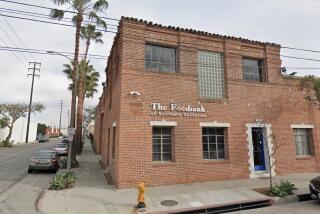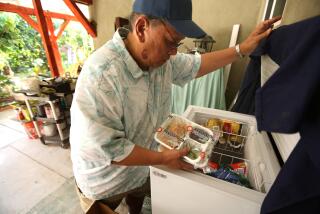Charities Fear Rise in Hunger as State Begins to Halt Aid
- Share via
Big-hearted people like Georgia Frantz at the suburban, cinder-block St. Anne’s Catholic Church in San Bernardino, and Donna Wing, at the grand First Congregational Church in downtown Riverside, are wondering how they will pick up where the federal government left off in feeding the poor.
Their plates already are full, providing emergency boxes of food and Wednesday night suppers to the indigent.
But now their job is becoming even more pressing. Last week, the first wave of federal welfare reform washed over the country. If unemployed, able-bodied adults under 50 have no dependents and had been receiving food stamps for at least three months, they were dropped from the rolls.
As many as 17,000 people in Southern California are immediately affected, officials estimate, and the issue now facing local charities is whether they have enough resources--food, volunteers and space--to fill the void created by the government’s overhaul of welfare.
The problem will grow dramatically as additional reforms--including the loss of food stamps for an estimated 270,000 legal immigrants in California--take effect later this year.
About 43,000 people statewide are affected by the first reforms. They picked up their last food stamps in February. The new law says the targeted people will have to find work, although they can reapply three years later for up to $120 in food stamps monthly.
That reform should not affect food stamp recipients in Los Angeles County, officials say, because the 10,000 or so unemployed people covered by the food assistance program can join the county’s long-standing workfare program and keep their eligibility.
Only those able-bodied food-stamp recipients who refuse to work 20 hours a week on jobs such as cleaning beaches, freeways and cemeteries will lose their food stamps. Another 40,000 or so Los Angeles County residents who receive food stamps will continue to do so because they already participate in workfare.
But in San Bernardino and Riverside counties--where there are no workfare programs--about 14,000 people have been dropped from the federal food stamp program, officials say. Another 2,350 people in San Diego County, 1,100 in Orange County and 240 in Ventura County also were dropped from the program. Some may return to the food stamp rolls if they show, on appeal, that they are physically unable to work.
The food stamp cutoff presents the first test of what will become an increasingly pressing question: Can we--and will we--feed the hungry when government says it won’t?
Those who have made it a career to feed the poor through charity say they have their doubts.
“We’re always out hustling,” said Harvey Mandell, vice president of the St. Vincent De Paul Village in San Diego. Already its kitchen serves 1,500 lunches daily--and Mandell expects the demand to grow by another 1,000 people a day, further straining his budget. “I don’t know how we can hustle any further,” he said.
Jeanette Arnquist of the Catholic Charities of San Bernardino/Riverside agreed that altruism in the Inland Empire may fall short of the need.
“I don’t see an overnight conversion among people stepping forward to really care for the people who need help the most,” she said. “Trying to replace that [food stamp] loss in a county with less than 2 million people isn’t going to happen. We’re going to come up short.”
Much of the food distributed to the indigent in the Inland Empire is funneled through the Survive Food Bank, which passes out about 500,000 pounds of food monthly through about 460 local charities, including churches and other organizations. The food--including aging perishables and food in mismarked or damaged packages--is donated by major grocery chains, distributors and manufacturers.
Even if more food can be obtained, another question is whether local charities can store it or provide sufficient volunteers to staff their operations, said Daryl Brock, executive director of the Survive Food Bank.
“We need people on the front lines doing the actual service, and they don’t necessarily have the resources, volunteers or financial wherewithal to provide the ongoing support that will be needed,” Brock said.
Frantz, who runs St. Anne’s food-giveaway pantry out of the church’s converted garage, says her parish already is doing all it can.
“We’re only able to offer emergency food assistance to the same person or family once every 2 1/2 or three months,” she said. “Now we’re getting people who had been receiving food stamps who now need help. But we can’t give to everybody, every week, like a corner grocery store. There’s not enough food.”
In Riverside, the First Congregational Church opens its basement multipurpose room every Wednesday night to feed the hungry, and as many as 300 show up weekly for casseroles, spaghetti, even hot dogs and beans.
“We quite honestly don’t have the capacity to feed many more,” Wing said. “We can’t pick up the government slack. It’s not possible. We’re very concerned. Some people will go hungry.”
The Salvation Army in San Bernardino feeds about 150 people nightly. Maj. Jacque Fritz, the facility commander, says she is unsure if more can be accommodated.
“What food we have is used up very fast--literally, day by day,” she said. “The public has given as much as it can give. I don’t understand how President Clinton can think there’s an unlimited amount of money in the county to pick up the slack. There’s not in this county.”
Gregory Knoll, head of the Legal Aid Society of San Diego, expressed similar concern. “I find it remarkable that [politicians] can see a problem and their answer is to rid themselves of the responsibility to solve it, as if that means it will go away. All it means is that the problem will grow and worsen. It’s a very sad state of affairs for poor people.”
The cutoff shocked many food stamp recipients, said Suzanne McCotter of the San Diego County Department of Social Services. “They haven’t followed the issue so they didn’t see it coming,” she said.
Donald Nolan, a 40-year-old San Bernardino resident, said he did not learn until last week that he had been dropped from the food stamp rolls.
Nolan, a former heating and air-conditioning technician who has been unemployed for about a year and has no car, said the time he otherwise would have spent searching for a job will now be consumed getting from one soup kitchen to another.
“Now I’m in a cycle of looking for food instead of work,” he said.
Arnquist at Catholic Charities said the loss of food stamps will have a domino effect. “These are people living in very fragile, delicately balanced situations,” she said. “Now people will use money they had spent on shelter to get food. I think we’re going to see a crisis that puts people on the street who weren’t there before.”
These single adults, she said, are not likely to generate as much public sympathy as poor families with young children.
“It’s easier to advocate food and services for children,” she said. “And in the minds of many people, the term ‘able-bodied, unemployed adult’ is a euphemism for ‘bum.’ But it could be someone who was disabled, lost a job, is now healed and simply can’t find work. And they’re no less deserving or less needy.”
Kathy Watkins of the San Bernardino County Department of Public Social Services estimated that 70% of the affected food stamp population already is homeless.
The county operates its own food bank, collecting about 250,000 pounds of food monthly from government and private sources and distributing it to local charities.
Herman Pena, who manages the San Bernardino County Food Bank, said there already is an insufficient amount of food to serve people on a regular basis.
“We’re already turning back people who need emergency food and it is going to get worse,” he said. “I come from a poor family, and I know what it’s like to not have food on a continuous basis--the feeling of not knowing where your next meal will come from. It’s very disheartening, very frustrating. It’s fearsome. It’s scary.
“I’ve been tossing and turning in bed, anticipating these changes, knowing there will be more people we can’t help. But most people are not concerned because they have food security.”
Times staff writer Tony Perry in San Diego contributed to this story.
More to Read
Sign up for Essential California
The most important California stories and recommendations in your inbox every morning.
You may occasionally receive promotional content from the Los Angeles Times.










